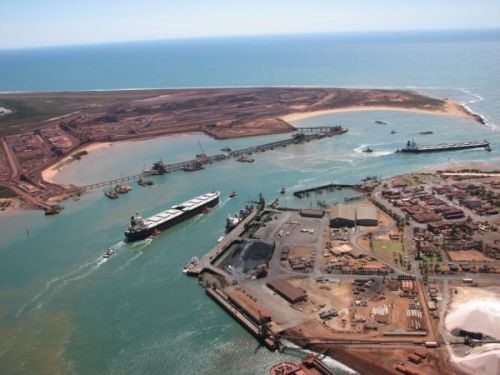Port Hedland

Port Hedland is a dynamic town in the Pilbara region of Western Australia, and is the second largest town in the region with more than 20,000 residents, including the satellite town of South Hedland located approx 18km away. By 2025, it is estimated that the town will achieve city status with 50,000 inhabitants. It is also the site of the highest tonnage port in Australia.
The original inhabitants, the Karriyarra people, call the place Marapikurrinya for the hand shaped formation of the tidal creeks coming off the natural deep anchorage harbour.

The Port is one of the world’s largest in export tonnage terms, shipping in excess of 240 million tonnes of bulk cargo in 2012. The major product exported is iron ore which is mined in the ranges located inland to the east and south of the town. Other major resource activities supported by the town include the offshore natural gas fields, salt, manganese, copper and chromite.
Grazing of cattle and sheep was formerly a major revenue earner for the region but this has slowly declined.
The climate is warm to hot, with mean maximum temperatures of 36.4 °C (97.5 °F) in January and 27.1 °C (80.8 °F) in July. Maximum temperatures in summer are usually moderated by a warm but humid sea breeze.

The two main residential centres are Port Hedland and South Hedland. Each has a range of community services including cultural, recreation and shopping facilities. Branches of major Banks are located in Wedge Street Port Hedland, while Commonwealth and State Government offices are mainly located in the South Hedland CBD. Cultural interests are catered for by a popular art gallery located in the CBD and a cultural precinct. State-of-the art sport and recreation facilities are found in both Port and South Hedland; there are several primary schools, a senior school in South Hedland as well as a TAFE and various day care facilities. Medical services are available in both centres; the South Hedland based Hedland Health Campus is a regional hospital operated by the WA Country Health Service.
The Wedgefield Industrial Area, located between Port and South Hedland, contains a variety of light and service industry premises; a new industrial precinct, close to the airport is being prepared for development to meet increasing demand. Undeniably, the major feature of the landscape of Port Hedland is currently the BHP Billiton Iron Ore Nelson Point iron ore shipping facility. Expansion of the port facilities to cater for the needs of other major mining companies such as FMG, Rio Tinto, Roy Hill and PMI will dramatically increase the activity in the area in the foreseeable future.

Port Hedland’s location on the ocean provides for a variety of aquatic leisure activities including superb fishing. Whales and nesting flatback turtles can be seen in season. The Town has a variety of accommodation for both business travellers and tourists, including backpackers, caravan parks, motels and quality hotels.
Tourism during the winter months sees the town bustling with people. Cruise ships have recently added Port Hedland to their itinerary as place of major interest along the West Australian coast.
Though recent negative media commentaries have portrayed Port Hedland in a mining resources downturn, there is much activity in the pipeline and developments are continuing with more in the planning stages. In expectation of the anticipated expansion of the town and the demand from major resource companies, the Town of Port Hedland will invest $70.5 million over the next five years to create a modern and well-serviced airport that provides a welcoming gateway to the North West. The redevelopment will include refurbishments, infrastructure upgrades, new subdivisions and new business opportunities. The new terminal and precinct will accommodate more than 700,000 passengers per year and an expansion of regional, national and international flights. Currently there are nearly 70 flights a week with daily flights to Perth and direct weekly flights to Brisbane, Melbourne and Bali, with a through put of 450,000 passengers per year.
Port Hedland is famous for its massive resource industry, long trains, big ships and salt piles. The town will retain its unique and vibrant status as an indomitable mining town and busy port as the next wave of resource expansion rolls in. On Aug 8 2013, presenter TV Leigh Sales asked Mr Mackenzie CEO of BHP if he thought Australia was transitioning out of the resources boom. He responded by saying "Not at all. I think maybe some of the best days are ahead of it." Mr Mackenzie also goes on to say "we're looking at the possibility of an increase in demand of about 75 per cent in the next 15 years." Great news for Port Hedland.
Media
- SEP 2013 THE AUSTRALIAN FINANCIAL REVIEW - ROY HILL CONTRACTS
- AUG 2012 BHP Media Release
- MAY 2013 BHP New GM Message
- MAY 2013 Govt Approves Waste Disposal
- JUN 2013 Roy Hill Article Perth Roadshow
- AUG 2013 ASX Release FMG Port $2.4BN Expansion Completion
- AUG 2013 FMG Joint Venture With Formosa $1.15BN
